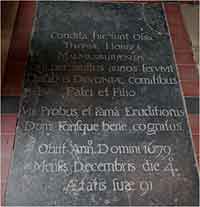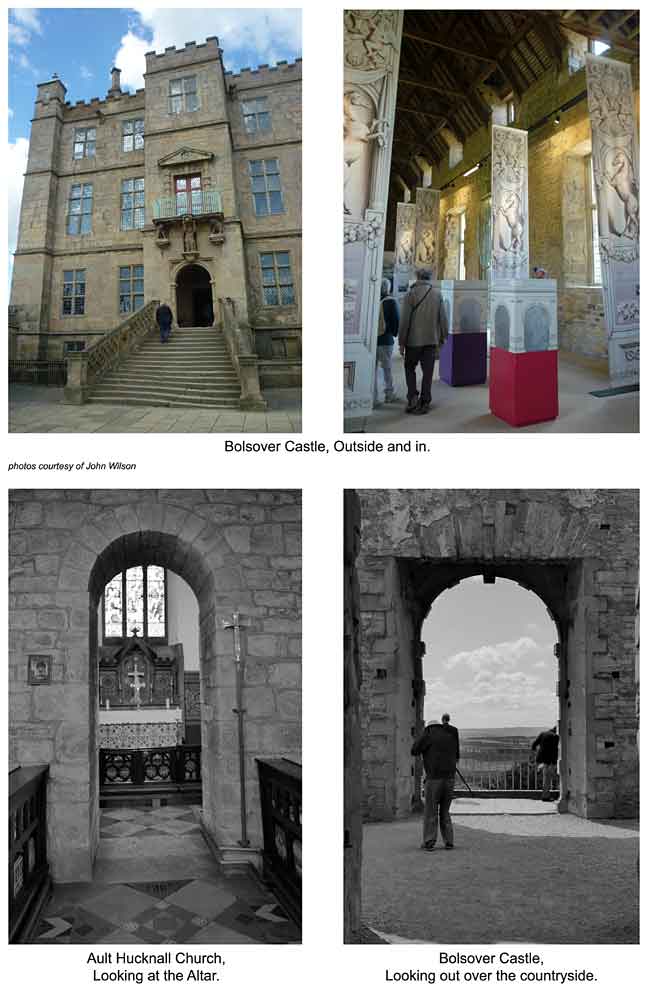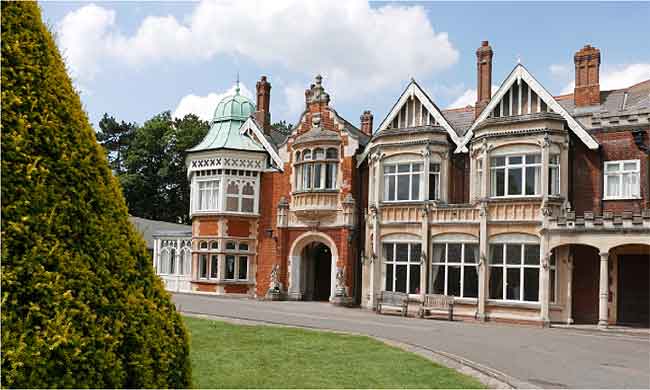Events and excursions, Summer 2019
EXCURSION REPORTS
TREASURES OF NORTH EAST DERBYSHIRE
TUESDAY 21st MAY 2019 LEADERS: CERIL LITTLE AND ADRIAN HENSTOCK
 On the floor of the Cavendish Chapel in Ault Hucknall Parish Church, this black slab covers the remains of Thomas Hobbes, one of England’s great philosophers.
On the floor of the Cavendish Chapel in Ault Hucknall Parish Church, this black slab covers the remains of Thomas Hobbes, one of England’s great philosophers. Living so close to Derbyshire we could perhaps be forgiven for assuming that we knew all the hidden gems of this beautiful county. Our excursion proved us wrong. Our first stop was to Ashover Church, where we were served coffee and cakes in what had once been the parish schoolroom. Our tour of the ancient church set in this idyllic Derbyshire village was led by Adrian Henstock, who had known this area very well in his early life. The immaculately carved pews and well-ordered interior hinted at the love and care given to the building by its people over the centuries. Adrian spoke of the features, which make the church so important: the great tomb of some members of the Babington family; the lead font with its moulded figures of saints (and buried for safety during the Civil War in a local garden) and the impressive reredos carved by a local man, George Eastwood. From Ashover, we journeyed along narrow roads to Ault Hucknall, where the church has a very small Saxon chancel, almost cut off from the rest of the building, as well as two Norman arches knocked through to create the North aisle, and three Gothic arches knocked through to create the South aisle. The vicar warmly welcomed us, and spoke of the building and especially of the tomb of Anne, Countess of Devonshire, and the memorial to the philosopher Thomas Hobbs.
Several members on the excursion had visited Bolsover before over the years, and perhaps may have felt that they knew all there was to know about this impressive castle. The talk we were given, however, soon dispelled these thoughts as the eloquent guide provided a fascinating account of facts and details about its history. We had lunch at Bolsover, and after the talk, we had time to wander around the rooms of the castle and see the fireplaces, and tapestries, and the wall panelling and painted ceilings. The central gardens with the Venus fountain are in immaculate order and give magnificent views from the ramparts of this part of Derbyshire. Strangely, the castle seems to have always been more of a picturesque country house rather than a fortification.

Alan Langton
Further to Alan’s report, there was some discussion at the church at Ault Hucknall as to whether the altar rail was Laudian (Archbishop Laud, Archbishop of Canterbury under Charles I, prevented the removal of altar rails by Puritans and encouraged their installation in all churches). Several members of the party thought that it could have been one. Does anyone have a copy of Pevsner’s The Buildings of England - Derbyshire by which we could check? Please let the Editor know, at editor@thorotonsocietv.orq.uk.
THE HISTORIC SITES OF SHERWOOD FOREST BY VINTAGE BUS
THURSDAY 20™ JUNE 2019 LEADERS: PETER HAMMOND AND ANDY GAUNT

Two initial surprises for this excursion: first, after days of heavy rain, the morning of 20th June gave us lovely sunshine for most of the excursion, and secondly rather than transport by a Sharpes’ coach members were boarded a red vintage London Transport Bus. Peter the driver and Andy the commentator are both archaeologists and they were able to lead forty Thoroton members around familiar places in the area of Sherwood Forest providing them with many unknown pieces of information as we travelled along.
We followed the old York Road north out of Nottingham (now the Mansfield Road) to Rufford, Andy describing the geology and the history of the various parts of the countryside en route. After coffee, we had a talk about the origins and history of the Cistercian Abbey and its royal connections. Our journey through Ollerton to Wellow gave a chance to see the splendid and well-used maypole on the village green. With delightful views of the countryside, and explanations of the Forest Boundaries and the different uses of sections of the woodland, we travelled through Ravenshead to Blidworth and on to Edwinstowe, with its historic connection with King Edwin of Mercia, and the supposed wedding of Robin Hood and Maid Marion.
Arriving at the impressive new Visitor Centre, we walked to The Major Oak, a majestic site carrying the untold history of nearly a thousand years in its lofty branches. After a lunch break we journeyed via Cuckney and Church Warsop to the site of the so-called ‘King John’s Palace’, although it seems to have been used as an extensive area for royal residences for several medieval monarchs. The excellent tour finished at Newstead Abbey where Peter spoke about its history of the abbey. After some refreshment in the cafe, we completed our circuit back to Nottingham.
A very different excursion for the Society, but a thoroughly enjoyable one, thanks to Peter and Andy.
Alan Langton
BLETCHLEY PARK
TUESDAY 16th JULY 2019; LEADER: ALAN LANGTON

Thirty-four members of the Society travelled with speed down the M1 motorway in lovely sunshine to arrive at Bletchley Park for our welcome, and the distribution of excellent history and guide books of this unique piece of English history, secret at the time, but now world-famous. This was a different type of excursion for Thoroton members: once inside the Park, we had over four hours to wander, explore, join a tour, have refreshments, and absorb the amazing story of the work that has made Bletchley so famous. The many hundreds of people, who had worked at Bletchley during World War 2, ensured that England knew as much about the movements of the enemies as they could discover. The guide who led the tour which I joined described in graphic detail the task of listening to messages (usually in code), and then the breaking of the codes, and then the transmission of the knowledge to the leaders who could deal with the information they received. So much of this work was achieved mainly by women, who had been sworn to secrecy when appointed, and who then worked often for at least six days a week in the buildings, totally isolated from life outside the boundary fence.
As the numbers of people needed for the work increased, so the number of buildings increased, which were often not particularly pleasant places in which to work. Meanwhile highly intelligent and committed people worked tirelessly to break the codes and ciphers by creating machines, which were eventually to lead to the development of the origins of computer technology that we take for granted today.
Codebreakers who were especially involved in this work were Alan Turing and Dilly Knox, and their work was so secret that even other people working at Bletchley were not aware of the developments taking place. An interesting section of documents and photographs on show also revealed how all the people who worked at Bletchley were appreciated and valued by the Government. During their free time were given opportunities for sport and music and drama and other pursuits on site, with some famous musicians and actors performing for them. We all enjoyed a fascinating and mind-blowing day, and returned to Nottingham somewhat dizzy with the size of the site and the scope of the work that we had seen on our excursion.